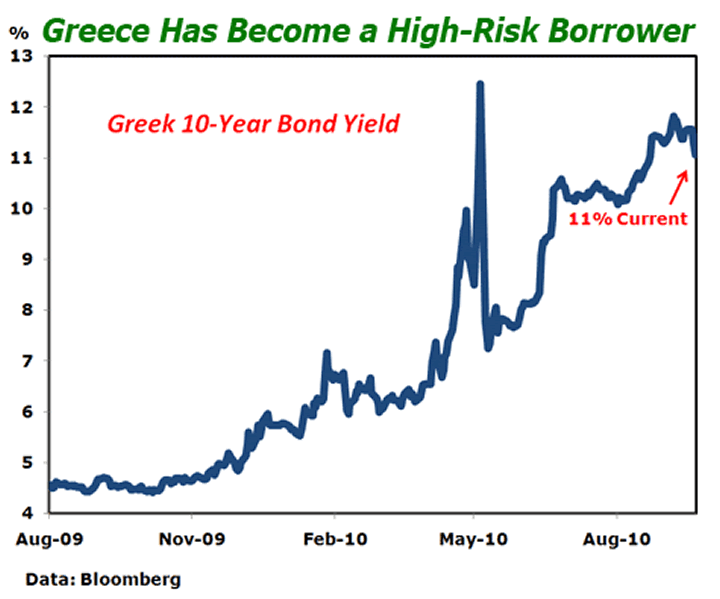Have You Considered International Bond ETFs For Income and Diversification?
Interest-Rates / International Bond Market Sep 23, 2010 - 08:28 AM GMTBy: Ron_Rowland
 In these turbulent times, plenty of investors just want steady income. Others realize they need to look outside the U.S. as they ride out the storm. Yet in a world where some once-stable economies are starting to look like emerging markets, they also see the need for diversification.
In these turbulent times, plenty of investors just want steady income. Others realize they need to look outside the U.S. as they ride out the storm. Yet in a world where some once-stable economies are starting to look like emerging markets, they also see the need for diversification.
Here’s an answer that ought to satisfy both needs: International bond exchange traded funds (ETFs). These offer a quick, easy way to round out your income portfolio with an asset class you may not have considered.
So today we’ll begin with a closer look at …
Bonds from Around the World
When you loan your money to someone — which is what you are doing when you buy any kind of bond — you expect to get a return on your investment. This is called the interest rate or yield, and is determined mainly by the amount of risk you’re taking.
If you loan your money to someone whom you are pretty sure will be around to pay you back, your return will be lower.
But when you loan your money to someone who may disappear before repaying you, you demand a higher interest rate. This is why people with no cash and no steady income get raked over the coals by lenders.
The same principle applies to governments and companies …
The U.S. government is a good example. Treasury bond interest rates are lower than just about everything else because the federal government isn’t going anywhere.
On the other hand, those that are considered riskier have to pay more when they borrow. For instance, nations like Greece with very high spending and a crumbling tax base are considered high-risk borrowers.
|
And some nations are in between. They aren’t nuclear superpowers like the U.S. — but they’re still relatively stable. Brazil, Poland, South Africa, and Malaysia are good examples. Their bonds have a good balance of limited risk and attractive reward.
Currencies Add to the Allure
|
With international bonds you also have an added twist: Currency values. You’re starting with dollars, and eventually you’ll need to withdraw dollars, too. Therefore, if you buy bonds denominated in a foreign currency and that currency appreciates against the dollar, your return will be higher. But any losses can be aggravated if the dollar gains on your chosen currency while you are in it.
As a lender, you have to find a balance between lower risk, lower return assets and riskier assets with potentially higher returns. The exact answer depends on your particular goals.
If international bonds look like a good fit for you, then ETFs are an excellent way to participate! You get a quick, inexpensive portfolio with one easy trade. Here are a few of the ETFs in this category you may want to consider:
- iShares JPMorgan USD Emerging Markets Bond (EMB) is the biggest international bond ETF and one of the most heavily traded by U.S. investors. True to its name, EMB holds government bonds from emerging market nations — but only bonds that are issued in U.S. dollar terms. That means this ETF has limited currency risk.
- Market Vectors Emerging Markets Local Currency Bond (EMLC) and WisdomTree Emerging Markets Local Debt (ELD) are a lot like EMB but with a huge difference: Both are composed of bonds issued in local currencies. By adding foreign currency exposure to the bond exposure, these two ETFs are doubly risky. But if the U.S. dollar declines, they could outperform as well.
- SPDR Barclays International Treasury Bond (BWX) sounds similar to EMB, but in fact there are big differences between the two. BWX has a broader scope and thus includes bonds from developed market nations like Japan, U.K., and Germany. These bonds are also issued in their local currencies. Whether this is helpful or not can vary. Over the last year, BWX severely lagged the performance of EMB because of weakness in the euro and British pound.
- SPDR DB International Government Inflation Protected Bond (WIP) is an interesting twist on this theme. WIP holds inflation-protected government securities from around the world. These are bonds that have an adjustment factor to compensate investors for any increase in the issuing country’s inflation benchmark.
- PowerShares International Corporate Bond (PICB) and SPDR Barclays International Corporate Bond (IBND) hold higher-yielding investment grade bonds issued by international companies rather than governments. Unfortunately, both these ETFs are quite small and illiquid. I hope this niche grows because it could be very useful in building balanced global portfolios.
One other innovation I’d love to see, but which doesn’t exist yet, is an international “junk bond” ETF. My guess is that at least one sponsor is working on the idea, although none have filed with the SEC for such a fund yet.
Several more international bond ETFs are out there, but the ones listed above cover most of the current menu. Take a closer look. With ETFs like these, you can transform your fund holdings into a worldwide portfolio.
Best wishes,
Ron
This investment news is brought to you by Money and Markets. Money and Markets is a free daily investment newsletter from Martin D. Weiss and Weiss Research analysts offering the latest investing news and financial insights for the stock market, including tips and advice on investing in gold, energy and oil. Dr. Weiss is a leader in the fields of investing, interest rates, financial safety and economic forecasting. To view archives or subscribe, visit http://www.moneyandmarkets.com.
© 2005-2022 http://www.MarketOracle.co.uk - The Market Oracle is a FREE Daily Financial Markets Analysis & Forecasting online publication.





